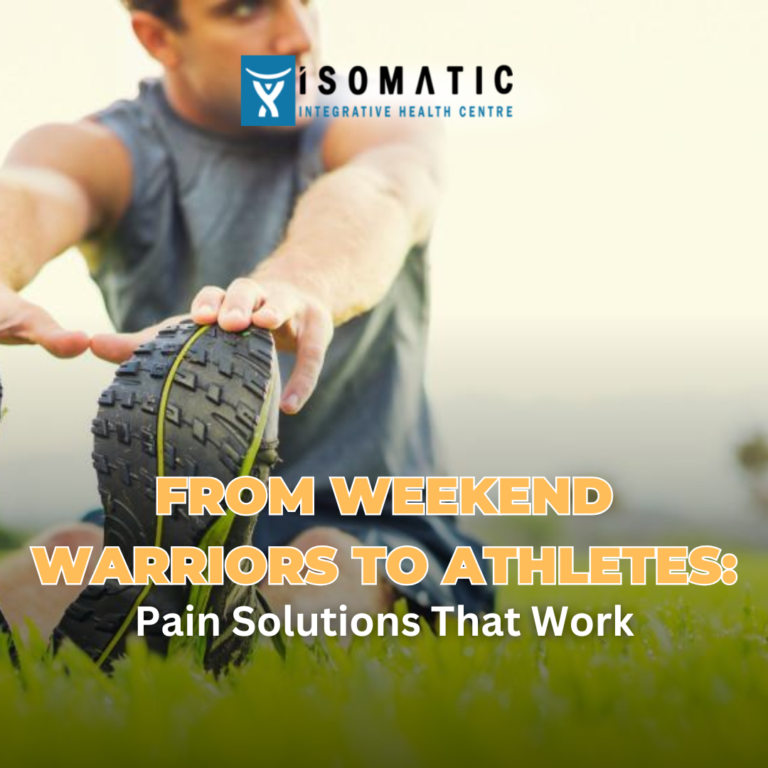
Can Physiotherapy Improve Your Immune System?
Can Physiotherapy Improve Your Immune System? Most people think of physiotherapy as treatment for injuries, pain, or movement limitations—but its benefits extend far beyond rehabilitation.

Neck pain can sneak up without warning—whether you’ve been glued to your laptop, stressed out, or slept “the wrong way.” While it’s incredibly common, it’s not something you have to live with. If you’re ready to stop merely coping and start healing, these expert-backed techniques from Isomatic will change the game.
At Isomatic, the focus isn’t just about masking discomfort with temporary fixes. It’s about treating the root causes—like poor posture, muscle imbalances, and daily habits that keep neck pain on repeat.
Let’s be honest—whether you’re a high-performing athlete chasing the podium or a desk-bound professional transforming into a weekend warrior, pain is part of the journey. You push your limits. You strive for more. And your body lets you know it. The keyword here is “from weekend warriors to athletes pain solutions that work”—and that’s exactly what we’re diving into today.
Pain, while often seen as a nuisance, is also feedback. It’s your body signaling, “Hey, something needs attention!” And ignoring it? That’s like covering a blinking warning light on your car’s dashboard with a sticker. It won’t end well. So, let’s uncover practical, science-backed ways to keep you pain-free and performance-ready.
Pain isn’t one-size-fits-all. For athletes, it could stem from overtraining, intense physical load, or repetitive strain. Weekend warriors often deal with delayed onset muscle soreness (DOMS), sprains, or just good ol’ poor posture from sitting all week.
The key culprits?
Overuse injuries like tendinitis and stress fractures
Imbalances caused by favoring one side of the body
Neglected recovery (yep, skipping cool-downs matters)
Inadequate warm-ups, causing muscle stiffness and joint vulnerability
What do all these have in common? They’re preventable, manageable, and—best of all—solvable
Active individuals commonly experience two main types of pain:
Acute Pain – The sudden kind that hits after a twist, fall, or wrong move (think sprained ankles).
Chronic Pain – Lingering discomfort from repetitive movement patterns, poor mechanics, or unresolved injuries.
Also worth noting:
Inflammation pain – Swelling or redness after workouts
Neuropathic pain – Tingling, burning, or numbness
Referred pain – Pain that travels (like shoulder issues causing neck pain)
Understanding what you’re dealing with is half the battle.
Let’s call them out:
Running – Shin splints, plantar fasciitis, runner’s knee
Tennis & Racquet Sports – Tennis elbow, wrist strain
Cycling – IT band syndrome, lower back pain
Weightlifting – Muscle tears, shoulder impingement
CrossFit/HIIT – Joint overload, tendon irritation
Noticing a pattern? High-rep or high-intensity activities without proper form or recovery equal pain.
Muscle pain is usually manageable. You stretch, rest, hydrate, and boom—you’re good in a day or two.
But joint pain? That’s a red flag. Joints like knees, shoulders, and hips aren’t as forgiving. They require:
Load management
Mobility work
Strengthening surrounding muscles
Sometimes, professional evaluation
Muscle soreness = common
Joint pain = caution
An ounce of prevention beats a pound of ibuprofen. Here’s your prevention checklist:
✅ Warm up dynamically – Don’t skip it.
✅ Stay hydrated – Muscles cramp without fluid.
✅ Mind your form – Technique > ego.
✅ Use supportive gear – Braces, insoles, etc.
✅ Don’t jump from couch to 5K – Build up gradually.
Your body thrives on preparation.
Nope, rest isn’t laziness—it’s science.
During rest, your muscles:
Repair microscopic tears
Replenish glycogen
Balance inflammation
Without recovery, you don’t adapt. You just break down. Active recovery (light walking, yoga, stretching) is your secret weapon.
Sleep and nutrition are the unsung heroes of pain management.
Sleep – Deep sleep restores tissue and releases growth hormone
Hydration – Flushes toxins and keeps muscles supple
Protein & anti-inflammatories – Support muscle healing
Add omega-3s and magnesium for an even bigger impact.
Sleep and nutrition are the unsung heroes of pain management.
Sleep – Deep sleep restores tissue and releases growth hormone
Hydration – Flushes toxins and keeps muscles supple
Protein & anti-inflammatories – Support muscle healing
Add omega-3s and magnesium for an even bigger impact.
If pain lingers, physical therapy isn’t optional—it’s essential.
PTs can:
Identify imbalances
Design corrective exercises
Provide hands-on treatments like cupping or manual release
And no, it’s not just for post-surgery recovery. Think of PTs as your personal movement mechanics.
Inflammation’s enemy #1 = Cold.
Apply:
Ice packs
Cold plunges
Cryo chambers (if you’re fancy)
Just don’t overdo it. 10–15 minutes max.
Heat opens blood vessels and relaxes tissue. Use:
Hot packs
Heating pads
Epsom salt baths
Use heat before activity to loosen up, or after to soothe tight muscles.
Foam rolling releases fascial tension and reduces soreness. It’s free, portable, and highly effective. Use:
Quads
Hamstrings
Calves
Lats
Daily 5–10 minutes can change your pain game.
Magnesium-rich baths = instant muscle relief.
How it works:
Draws out lactic acid
Reduces inflammation
Relaxes nervous system
Add essential oils (lavender or eucalyptus) to double the effect.
Boost your body’s internal pharmacy:
Turmeric + Black Pepper – Curcumin fights inflammation
Omega-3s – Reduces joint pain
Collagen – Supports tendons and ligaments
Magnesium – Calms nerves and muscles
Always consult a pro before starting new supplements.
You can’t out-train a bad diet. Include:
Leafy greens
Berries
Avocados
Nuts and seeds
Anti-inflammatory spices (turmeric, ginger)
Limit: processed foods, sugar, trans fats
Your shoes might be the silent cause of your pain.
Key gear rules:
Replace running shoes every 300-500 miles
Use orthotics if needed
Wear braces/support when recovering
Invest in gear like you invest in training.
Strong muscles protect joints. Focus on:
Core stability
Glute activation
Unilateral training
Functional movements
Lift smart, not just heavy.
TENS (Transcutaneous Electrical Nerve Stimulation) devices send tiny shocks to interrupt pain signals.
Best for:
Muscle soreness
Joint pain
Nerve issues
Use post-workout or during rest days.
Don’t underestimate the brain’s role.
Try:
Yoga – Combines mobility and breath
Meditation – Lowers pain perception
Breathwork – Oxygenates tissues
Visualization – Improves recovery mindset
Pain isn’t just physical.
TENS (Transcutaneous Electrical Nerve Stimulation) devices send tiny shocks to interrupt pain signals.
Best for:
Muscle soreness
Joint pain
Nerve issues
Use post-workout or during rest days.
TENS (Transcutaneous Electrical Nerve Stimulation) devices send tiny shocks to interrupt pain signals.
Best for:
Muscle soreness
Joint pain
Nerve issues
Use post-workout or during rest days.
What’s the fastest way to relieve muscle soreness?
Foam rolling, hydration, and light movement (like walking or yoga) are best.
Are pain relief creams effective?
Yes, especially menthol or CBD-based creams for localized relief.
When should I use ice vs. heat?
Use ice for inflammation/swelling, heat for stiffness or tension.
Is stretching enough to prevent pain?
No. Combine with strength training and mobility work.
Can I exercise with pain?
Light pain = modify. Sharp/stabbing pain = stop and consult a pro.
Do supplements actually help with joint pain?
Yes, especially turmeric, omega-3s, and collagen—but consult your doctor.
Pain doesn’t have to sideline you. Whether you’re crushing workouts five times a week or living for the weekend hike, understanding and managing pain is essential. Implement these pain solutions that work—from foam rolling to physical therapy, nutrition to rest—and you’ll move better, feel stronger, and thrive longer.

Can Physiotherapy Improve Your Immune System? Most people think of physiotherapy as treatment for injuries, pain, or movement limitations—but its benefits extend far beyond rehabilitation.

Headaches and Tension? Try These Hands-On Osteopathic Solutions Headaches caused by tension can be draining, distracting, and downright frustrating. Whether they come from long hours

Isometric Exercises: Why We Recommend Them in Recovery When you’re healing from an injury, not all exercises are safe—some movements can even set you back.